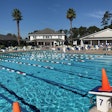SOURCE: Les Mills
New research has for the first time set a recommended upper limit of High-Intensity Interval Training (HIIT) at 30-40 minutes working out at above 90 percent of the maximum heart rate per week.
The study findings – presented by Associate Professor Jinger Gottschall at the 2018 American College of Sports Medicine (ACSM) Annual Meeting this month – provide evidence that any more than 30-40 minutes of HIIT in a maximum training zone per week can reduce performance and potentially result in a greater risk of injury.
According to Gottschall the research findings highlight the urgent need for evidence-based guidelines around HIIT.
“Currently there are no guidelines concerning the greatest amount of HIIT people should do in a week for the optimal the training effect,” she says. “Given the extreme intensity* involved in this kind of exercise, it’s imperative that maximum guidelines are provided in the same way that minimum guidelines have been in the past. We hope this study will be instrumental in helping make these recommendations official.”
Bryce Hastings, Head of Research at Les Mills – who worked in collaboration with Professor Gottschall on the research – says: “What our research findings tell us is that there is only so much HIIT a regular exerciser can do in one week before the effects are compromised.
“The findings have scientifically established that less is more when it comes to HIIT and that any more than 30-40 minutes working out at above 90 percent of the maximum heart rate per week doesn’t help achieve transformative effects. In fact, too much actually hinders.”
The key lies in the nature of HIIT itself. By pushing the body into its maximum training zone for short periods, a positive stress response is triggered that creates bio-chemical changes in the body that help build new muscle and improve fitness. This can be measured effectively by examining cortisol and testosterone concentrations in saliva samples.
“In scientific terms, what we’ve observed by measuring the stress response in the saliva of our study participants is that those who do more than 30-40 minutes of HIIT per week are unable to produce a positive stress response,” says Gottschall.
“If you want to get the best possible results from HIIT, our recommendation, based on these findings, is to balance your weekly HIIT sessions with other, less intense cardiovascular and strength workouts. It’s also imperative that you let your body recover properly after a HIIT session. This way, you’re likely to perform better when you do your HIIT workouts and benefit from the positive results.”
* High-Intensity Interval Training typically involves periods of extreme exertion where you push your heart rate to greater than 85 percent of your maximum capacity followed by periods of rest.
About the study
After evaluating the heart rate profiles of thousands of athletes in the last 20 years and completing three different studies using Les Mills’ HIIT programming, Gottschall hypothesized that approximately 30-40 minutes of intensity above 90 percent max per week is optimal to allow for proper recovery and ideal performance. This study backs up this recommendation.
For the study, 35 active individuals (28 women and 7 men) who exercise more than 8 hours per week recorded their heart rate during every training session and answered surveys regarding their mood for three weeks.
Then on an experimental day, at the end of their typical three week training period, participants did two high-intensity workouts - in the form of LES MILLS GRIT™ - four hours apart. Saliva samples were collected 30 minutes prior to each exercise session, immediately following and 30 minutes post-exercise to assess cortisol and testosterone concentrations. This process enabled the team to track the individual’s stress response. Heart rate was also monitored throughout the experimental day using Polar A370 devices with the H10 chest straps to determine exercise and recovery values.
The results show a correlation between weekly time spent training at an intensity greater than 90 percent maximum heart rate and the symptoms of overreaching.
Note:
These study findings were presented at the 2018 ACSM Annual Meeting by Penn State’s Associate Professor, Jinger Gottschall. Journal publication of the study is currently pending.
About LES MILLS
Les Mills International is the creator of 20 global group fitness and team training programs, including BODYPUMP™ (weights), BODYCOMBAT™ (martial arts), RPM™ (indoor cycling), LES MILLS GRIT™ (30-minute high-intensity interval training) and LES MILLS SPRINT™ (high-intensity cycling). Every week, millions of people get fit in 20,000 clubs across 100 countries with the help of 140,000 Les Mills instructors. In the U.S. alone, Les Mills has 33,000 highly-trained instructors teaching at 3,800 gyms and clubs.
About Les Mills Research
Significant investment in ongoing research is an important part of Les Mills’ business, and enables its club partners and their members to know that LES MILLS group fitness programs are effective and safe. Les Mills partners with universities around the world to conduct research to investigate areas of exercise science it wants to find out more about and test the effects of its programs on key community health factors such as obesity and heart disease. Its research is independent, peer-reviewed and industry-recognized.
For more information, visit lesmills.com/research































